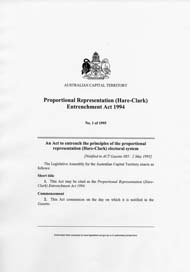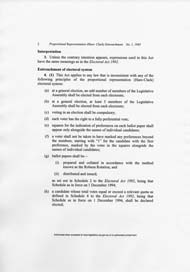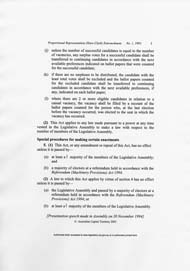

ACT Proportional Representation (Hare-Clark) Entrenchment Act 1994 (ACT)
Significance
Enacted on 2 May 1995, this Act ensured that there would be no change to the proportional representation system (known as Hare-Clark) for elections to the ACT Legislative Assembly, unless approved by voters at a referendum. This Act is thus ‘entrenched’ – it cannot be changed, except by referendum.
Enactment of legislation of Australia’s state and federal parliaments is by Assent, which must be signed by the Queen or her vice-regal representative – the State Governor, or the Governor-General. By contrast the ACT enacts its own laws, by notification. Notification of this Act was by publication in the ACT Government Gazette on 2 May 1995.
History
The Australian Capital Territory (Self-Government) Act 1988 provided for a fully elected Legislative Assembly, with 17 members elected by proportional representation with multi-member electorates. Preferential voting is used, where voters indicate their rating of the candidates. The votes are counted with the candidate obtaining the fewest first preferences eliminated and each voter’s second preference counted. This process continues until the required number of candidates for each electorate remain.The first election on 4 March 1989, under the modified d’Hondt system, returned a Labor government with a majority of only one seat. The Chief Minister, Rosemary Follett, was the first woman to head a government in Australia. The instability of the government’s majority led to a spill in 1990, when Chief Minister Rosemary Follett was replaced by Trevor Kaine. The continued instability meant a second spill the following year, when Follett became Chief Minister again.
At the second election on 15 February 1992, a plebiscite was held on optional electoral systems. The third election on 18 February 1995, a trial of proportional representation, with three multi-member electorates, returned a Liberal government led by Kate Carnell, with a majority of one. A second plebiscite held with this election approved the Hare-Clark system used in subsequent elections in 1998, 2001 and 2004. The first majority government was returned in 2004, when the Labor government, led by Jon Stanhope, was re-elected.
Sources
Grundy, Philip et al, Reluctant Democrats: The Transition to Self-Government in the Australian Capital Territory, Federal Capital Press, Fyshwick, 1996.
Halligan, John and Wettenhall, Roger (eds), A Decade of Self-Government in the ACT, University of Canberra, Canberra, 2000.
Description
| Long Title: | An Act to entrench the principles of the Proportional Representation (Hare-Clark) system (Act 1 of 1995) |
| No. of pages: | Cover + 14 pages |
| Medium: | Paper |
| Provenance: | Legislative Assembly of the Australian Capital Territory |
| Features: | The Coat of Arms of the City of Canberra on the front cover |
| Location: | Online at www.legislation.act.gov.au |
| Reference: | Act 1 of 1995 |


